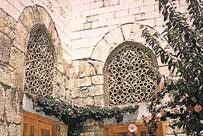(ST)- When Europe was punishing psychopaths by beating and murder, in the belief that they were inhabited by evil spirits, the Arabs were establishing specialized hospitals for their treatment.
A good example is Argun Bimaristan, which was established in 755 AH / 1354 AD. It is considered a typical and specialized hospital for treating mental and psychological illnesses. “Bimarstan” a word of Persian origin, Bimar means (patient) and Stan (a place or house) which means the house of patients.
The Bimarstan is located in Bab Qinsreen quarter in the city of Aleppo. The Directorate of Aleppo Antiquities and Museums employed the Bimarstan as a museum of medicine and science at Arabs. It includes six wings with distinctive architectural style, like other Islamic buildings in that period; it is resistant to earthquakes through the carriers of brackets absorbing earthquakes in addition to a soundproofed room to heat, cold and sound.
Bimarstan, which is one of the Islamic beautiful buildings, was built during the reign of Prince Seif Eddin Argun bin Tijo al Kamili in the days of the King al -Saleh bin al -Sultan al-Malik al-Nasir Muhammad bin Qalawoon in 1354 AD. Seifeddin Tija supervised the building work.
The main entrance of Bimarstan is at the most of beauty and creativity of workmanship. It consists of a half dome with three rows of stalactites, which was distributed in a technical careful shape.
The entrance leads to the a small lobby including a large compartment, to the north a section dedicated to drugs and two rooms to south, one is for waiting and the other perhaps for preview. From the lobby, you get to uncovered yard of the Bimarstan, which includes water well with two openings. The rooms of the Bimarstan are distributed on two arcades east and west of each one has four columns, and twelve small rooms spread on the two arcades and each room can accommodate to one patient.
 There are three separate wings for each completely different from each other in terms of engineering and cases in which it treats. There is a pavilion for dangerous situations, and consists of a square courtyard a square pond. The pavilion contains four compartments by iron bars, the compartment is of a small area and only a few of the light of day enters to it to reduce the severity of the agitation of the patient.
There are three separate wings for each completely different from each other in terms of engineering and cases in which it treats. There is a pavilion for dangerous situations, and consists of a square courtyard a square pond. The pavilion contains four compartments by iron bars, the compartment is of a small area and only a few of the light of day enters to it to reduce the severity of the agitation of the patient.
There is also a suite of ordinary patients. It consists of a rectangle entrance with a pond in the middle, containing eleven rooms with an open dome from the top for ventilation and lighting. It offers services to treat women isolated from the men’s rooms.
The Bimarstan displays the history of the Arab medicine by offering cut-outs for people being treated, as well as glimpses of the lives of the most prominent Arab scholars and their achievements and methods of treatment that they followed and medical instruments, which invented and developed. You can see the corner of Ibn al-Haytham, al –Khwarizmi, al-Farabi and al –Kashi.
Sharif al -Khatib

